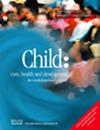Reliability and Construct Validity of the Self-Report Version of Strengths and Difficulties Questionnaire in Children and Adolescents With Cerebral Palsy
Abstract
Background
Children and adolescents with childhood-onset physical disabilities, including cerebral palsy (CP), face a significantly higher risk of developing mental health disorders due to factors such as reduced physical activity, participation limitations, sleep disturbances, pain, social isolation, rejection, bullying and victimization. Therefore, identifying mental health problems in this population is crucial for promoting their mental health and psychosocial well-being. This study aimed to investigate the reliability and construct validity of the self-report Strengths and Difficulties Questionnaire (SDQ) in children and adolescents with CP.
Methods
The study included 120 children and adolescents with CP (mean age = 14.13 ± 2.2 years), representing the full spectrum of CP subtypes. Internal consistency was assessed using McDonald's omega (ω). Test–retest reliability was assessed using intraclass correlation coefficients (ICC) to estimate the level of consistency in scores for 50 children and adolescents who completed the SDQ again after 14 days. Three types of construct validity were assessed: factorial, convergent and known-group validity. Factorial validity was assessed based on the model fit of structural equation model-based confirmatory factor analysis (CFA). For CFA, the following fit indices were considered acceptable: a Root Mean Square Error of Approximation (RMSEA) < 0.08, a Goodness of Fit Index (GFI) ≥ 0.95 and a Standardized Root Mean Square Residual (SRMR) ≤ 0.08. Convergent validity was assessed by estimating correlations between the SDQ and Cerebral Palsy Quality of Life (CP QOL) scores using Pearson correlation coefficient (r).
Results
Internal consistency and test–retest reliability of both SDQ Total Difficulties Scale and SDQ Prosocial subscale were found to be acceptable (ω: 0.73–0.85; ICCs: 0.77–0.96). The SDQ's factor structure showed good fit (Total Difficulties Scale: RMSEA = 0.03, GFI = 0.95 and SRMR = 0.037; SDQ Prosocial: RMSEA = 0.025, GFI = 0.97 and SRMR = 0.066). Acceptable correlations between SDQ and CP-QOL scores (r = 0.53–0.93) supported convergent validity. Known-groups validity was confirmed, with children with CP showing significantly different SDQ scores compared to their TD peers (p < 0.05).
Conclusion
Our findings provide evidence of adequate internal consistency reliability, test–retest reliability and construct validity for scores on the SDQ for children and adolescents with CP.
Trial Registration: ClinicalTrials.gov identifier: NCT06527508.
Key Messages
- This is the first study investigating the measurement properties of the self-report SDQ in children and adolescents with CP
- This study yielded satisfactory evidence for the factorial validity, convergent validity and known-group validity of the self-report SDQ, supporting its suitability as a tool for assessing the mental health status of children and adolescents CP aged 11–17 years.
- All items in the self-report SDQ were found to effectively measure the intended construct-mental health-demonstrating item homogeneity and supporting internal consistency
- The satisfactory agreement between SDQ scores obtained over a two-week interval demonstrated the instrument's temporal stability, indicating strong test–retest reliability.

 求助内容:
求助内容: 应助结果提醒方式:
应助结果提醒方式:


